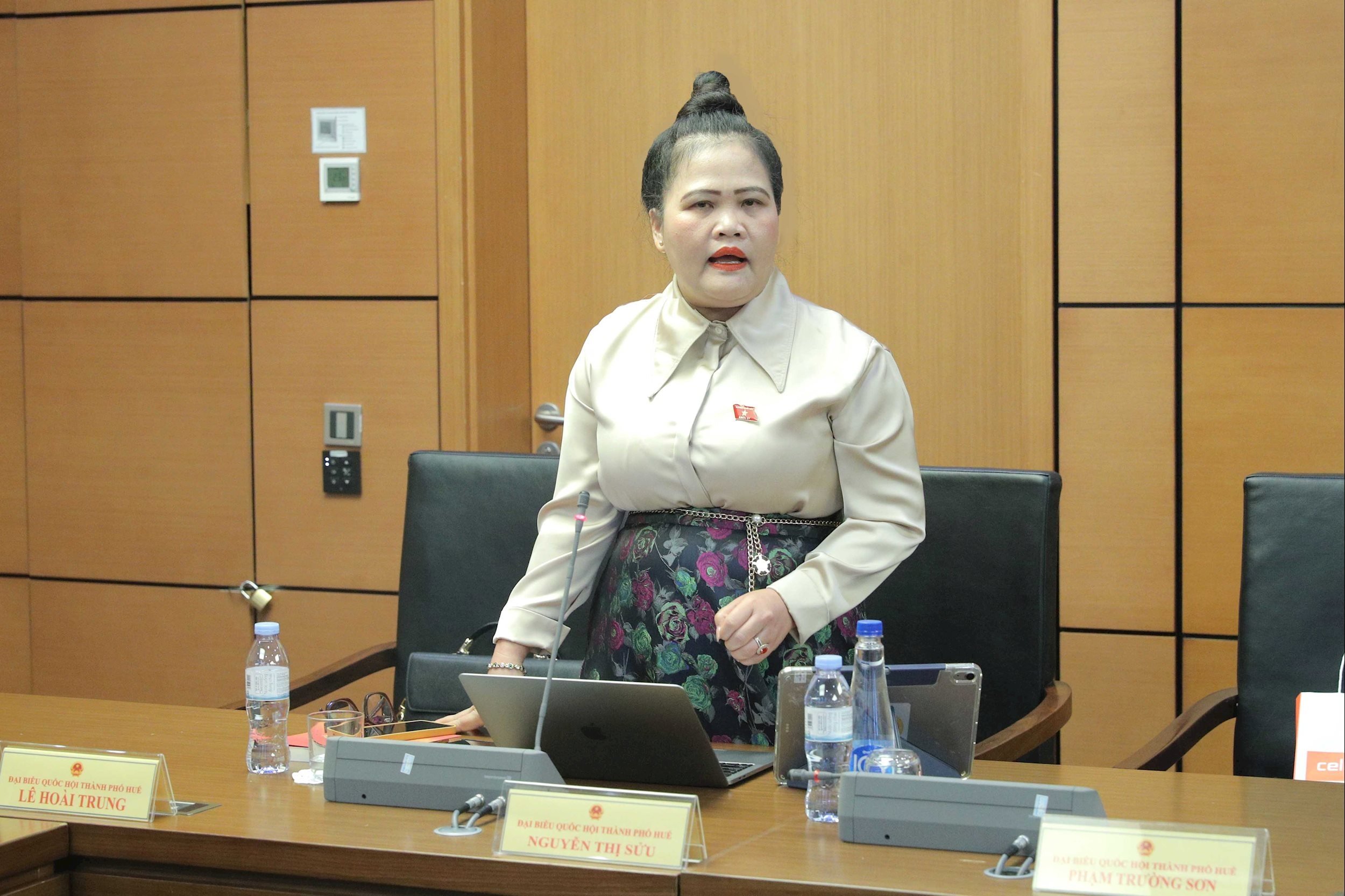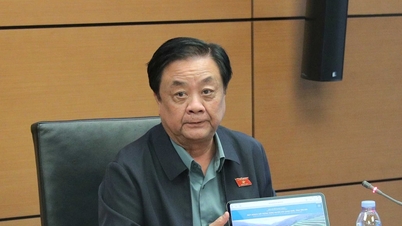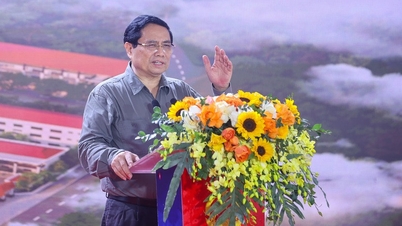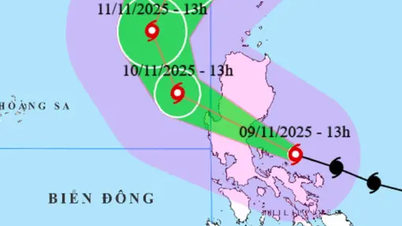This morning, November 7, discussing at group 6 (National Assembly Delegation of Lang Son, Dong Nai, Hue City) on the draft Law on Planning (amended) and related draft laws and resolutions, the National Assembly Deputies said that the current planning system is still overlapping and lacking connectivity, causing difficulties for socio-economic development. Accordingly, it is proposed to revise the draft Law towards synchronization between levels, application of modern technology, strengthening supervision, social criticism and ensuring regional identity and characteristics in development planning.

Scene of the discussion session at Group 6 on the morning of November 7. Photo: Ho Long
Ensuring publicity and transparency in planning
According to National Assembly Delegate Nguyen Thi Suu ( Hue City), comparing the three drafts ("Law on Planning", "Law on amending and supplementing the Law on Urban and Rural Planning", "Resolution on adjusting the National Master Plan 2021-2030") shows that there are similarities, overlaps, and inconsistencies that need to be adjusted.
Regarding the planning period and vision, National Assembly Deputy Nguyen Thi Suu said that the current draft laws stipulate different periods and visions, leading to a lack of consistency. Specifically, the Law on Planning (Article 7) stipulates a period of 10 years, a vision of 30 years; the Law on Urban and Rural Planning (amended) stipulates a general planning period of 20-25 years, a vision of up to 50 years; while the Resolution adjusting the National Master Plan sets the target until 2030, a vision to 2050 (equivalent to 10 years and 30 years). "This difference makes the Law on Planning and the Law on Urban - Rural Planning not synchronized, while the Resolution is consistent with the latter law but deviates from the former law" - the delegate emphasized.
To ensure consistency, delegates suggested that it is necessary to stipulate the period and vision according to the same standard, or the Planning Law should increase the period to 20-25 years, and the Urban and Rural Planning Law should reduce it to 10 years. However, the most suitable option is to unify with the Resolution, that is, a period of 10 years, a vision of 30 years, to ensure synchronization between the national master plan and the lower-level plans.

National Assembly Delegate Nguyen Thi Suu (Hue City) speaks at Group 6. Photo: Ho Long
Regarding the relationship and handling of conflicts between types of planning, delegates also said that currently, all draft laws have provisions related to handling overlaps and conflicts between levels and types of planning. Specifically, Article 6 of the draft Law on Planning (amended) stipulates the principles for handling conflicts between national, regional, provincial and sectoral planning; Article 5 of the draft Law amending and supplementing a number of articles of the Law on Urban and Rural Planning mentions handling overlaps between urban, rural, economic zone and national tourist planning; and the Resolution adjusting the National Master Plan emphasizes the requirement to "effectively exploit new development space after merging and rearranging administrative units". However, there are still legal gaps between the documents: there are no specific regulations on handling planning when changing administrative boundaries, as well as a lack of a mechanism for connecting national master plans and detailed urban - rural plans.
Therefore, delegates proposed to add to Article 6 of the draft Law on Planning (amended) provisions on reviewing and adjusting planning in case of merging, separating, and adjusting administrative units; at the same time, add to the draft Law on amending and supplementing a number of articles of the Law on Urban and Rural Planning a coordination mechanism to ensure consistency and synchronization between planning levels.

National Assembly Delegate Le Hoang Hai (Dong Nai) speaks. Photo: Ho Long
Agreeing with the need to promulgate the Law on Planning (amended) according to the Government's Submission, Delegate Le Hoang Hai (Dong Nai) said that the draft Law needs to continue to be improved in the direction of increasing publicity, transparency and people's supervision, while ensuring consistency between levels and types of planning. Regarding the supervision of planning activities (Article 14), the delegate commented that the current regulations are still general, only referring to other laws without creating a proactive and substantive supervision mechanism. The delegate suggested that it is necessary to clearly define the role of the Vietnam Fatherland Front in presiding over the supervision and social criticism of the stages of planning preparation, appraisal, approval and adjustment that directly affect the people. At the same time, it is necessary to supplement the responsibility of the planning preparation and approval agency in receiving, resolving and publicly responding to recommendations, reflections and denunciations of relevant organizations and individuals.
Regarding the consultation on planning, delegate Le Hoang Hai also acknowledged that the current form of consultation is still formal, mainly online or in writing, which does not create conditions for people directly affected to participate. Accordingly, to ensure transparency, the delegate proposed to make it mandatory to consult the community on planning that affects people's lives. The planning must be publicly posted at the headquarters of the People's Committee at the commune level and at community meeting places. In addition, the planning agency needs to explain specifically for each comment, stating clearly the reasons for not accepting it, especially the comments of the community and social organizations.
Regarding the announcement of planning and the national planning information system (Articles 42-45), delegate Le Hoang Hai also said that the announcement of planning is currently one-way, making it difficult for people - especially in remote areas - to access information. Accordingly, the delegate proposed that the announcement content should be presented visually, easy to understand, with a summary explanation attached. The national planning information system should be designed to be user-friendly, allowing data to be looked up by land plot location; at the same time, mandatory regulations on the quality, update and legality of input data should be added. The delegate also suggested applying modern technology such as artificial intelligence to automatically compare and warn of conflicts between plans.
Overlapping handling, integrated planning
Agreeing with the spirit of adjustment to overcome the overlapping and inadequacies in the planning system, National Assembly Deputy Trinh Xuan An (Dong Nai) highly appreciated the provisions in Articles 5 and 6 of the draft Law on Planning (amended), considering this as the basis for handling conflicts between types of planning. However, the delegate also said that it is necessary to clarify the priority mechanism when there are conflicts between types of planning, because the current regulations do not clearly define which level will be given priority.

National Assembly Delegate Trinh Xuan An (Dong Nai) speaks at Group 6 about the draft Law on Planning (amended). Photo: Ho Long
Regarding urban and land planning, delegates suggested that for special urban areas such as Hanoi and Ho Chi Minh City, all types of planning should be integrated, keeping only one or two main types to avoid overlap. Land use planning should be converted into quantitative indicators instead of separate planning, and the situation of specialized technical planning (such as aviation, railways, etc.) operating in parallel, lacking connection with the overall planning, should be put an end.
Regarding the content of the National Master Plan, delegate Trinh Xuan An proposed to remove the list of key projects because many large projects have been clearly identified in the infrastructure section. If it is still kept, it is necessary to complete the list in a complete and phased manner, linked to capital sources and adjust strategic targets to be closer to reality.
Regarding regional structure and regional linkage, delegates emphasized: it is necessary to clarify the development orientation and linkage mechanism when changing regional boundaries. The redesign of the South Central Coast and Central Highlands regions needs to be studied more deeply to form a corridor linking the sea and the plateau, avoiding the situation where the regional content is still fragmented, only connecting in the tourism part.
Notably, regarding national defense and security, National Assembly Deputy Trinh Xuan An proposed adding the principle of ensuring national defense and security in the National Master Plan, closely linking it with the defense zone posture, reorganizing regular and local forces, and ensuring the arrangement of development space in parallel with territorial security and national safety.
Agreeing with the above opinion, National Assembly Deputy Nguyen Hai Nam (Hue City) also said that after many years of implementation, the 2017 Planning Law has revealed many problems and shortcomings, especially in three aspects: slow implementation progress, overlap between types of planning, and lack of database and implementation resources. The delegate emphasized the need to strongly reform administrative procedures so that planning adjustments and amendments are more flexible and timely, and at the same time thoroughly resolve conflicts between socio-economic development planning and resource planning such as mineral exploitation.
Along with that, the Drafting Committee needs to review and adjust the administrative decentralization model when switching from three levels to two levels to ensure consistency and transparency in planning management. "For planning to be effective, it is necessary to promote the mobilization of social resources, not just relying on the state budget, to meet the requirements of development and implementation of planning effectively, synchronously and on schedule" - the delegate emphasized.
Source: https://daibieunhandan.vn/lay-y-kien-cong-dong-dan-cu-doi-voi-cac-quy-hoach-tac-dong-den-doi-song-dan-sinh-10394813.html


































































































![Dong Nai OCOP transition: [Part 2] Opening new distribution channel](https://vphoto.vietnam.vn/thumb/402x226/vietnam/resource/IMAGE/2025/11/09/1762655780766_4613-anh-1_20240803100041-nongnghiep-154608.jpeg)













Comment (0)